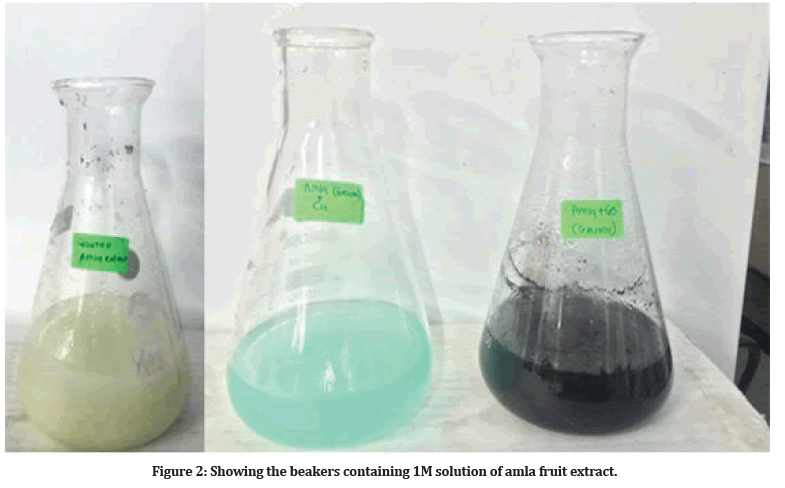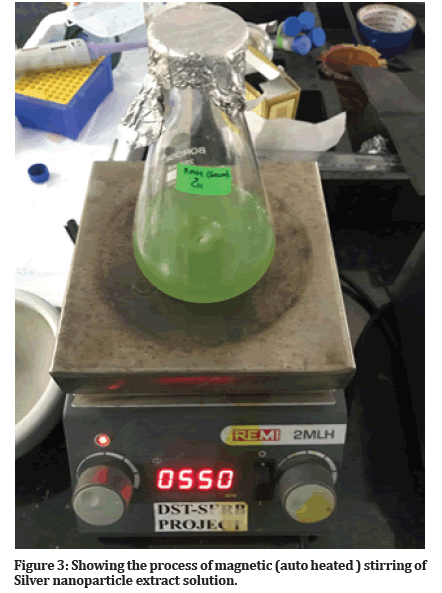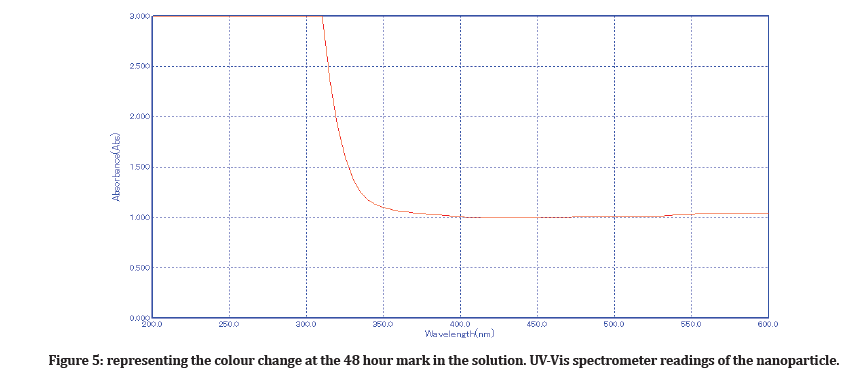Research - (2022) Volume 10, Issue 8
Green Synthesis, Characterization and Assessment of Anti-inflammatory and Antioxidant Properties of Silver Nanoparticles Prepared using Amla Extracts-An In-vitro Study
Divij Khullar* and Nabeel Ahmed
*Correspondence: Divij Khullar, Department of Prosthodontics, Saveetha Dental College and Hospital, Saveetha Institute of Medical and Technical Sciences, Chennai, India, Email:
Abstract
Toxic chemicals are used in traditional nanoparticle synthesis processes, resulting in environmental toxicity. As a result, we must switch to "green synthesis." Previous studies have shown that Silver nanoparticles reinforced with Amla extract have excellent antimicrobial properties. As a result, this research was carried out to determine the anti-inflammatory and antioxidant properties of Silver. Since Silver induces cell wall lysis due to intracellular material leakage, it is an excellent antimicrobial agent and was chosen to make a nanoparticle. Aim: Aim of the study was phyto assisted preparation of Silver nanoparticles from Amla fruit and evaluation of its anti-inflammatory and antioxidant properties. Material and methods: Anti-inflammatory and antioxidant properties of the nanoparticle were assessed using Bovine Serum Albumin (BSA) and DPPH Assay respectively at 10 µL, 20 µL, 30 µL, 40µL, 50 µL. Results: Values for anti-inflammatory property of nanoparticles were higher than the standard values at 40µL, 50 µL concentrations. Percentage of inhibition was highest at 40 µL (86%) and 50 µL (84.6%). The values for antioxidant property of nanoparticles were found to be higher than the standard values at concentrations except at 40 µL, 50 µL. Percentage of inhibition was highest at 20 µL (86.2%) Conclusion: Within the limits of the study it can be concluded that Silver nanoparticles have exceptional anti-inflammatory and antioxidant properties and further can be incorporated in dental material or can be used to coat suture materials to improve their properties.
Keywords
Silver, Characterization, Green synthesis, Nanoparticle, Anti-inflammatory, Antioxidant properties
Introduction
Nanotechnology is a relatively modern technology that has ushered in a new era in the area of research. In recent years, nanoparticles have received a lot of attention in the scientific community. Optics, electronics, biomedical, and materials sciences have all benefited from this technology [1]. Some of the highlighted advantages of nanoparticles in recent years include potent antimicrobial, anticancer, antioxidant agents, drug and gene delivery, and so on [2–4]. Nanotechnology is concerned with nanoparticles, which are atomic or molecular aggregates with a scale of less than 100 nanometers [5]. There are essential elements that have had their atomic and molecular properties modified [6].
Chemical reduction, laser ablation, solvothermal, inert gas condensation, sol-gel process are some of the traditional methods used to make Silver nanoparticles. Even though traditional physical and chemical methods take less time to synthesize large quantities of nanoparticles, toxic chemicals are needed as capping agents to maintain stability, resulting in environmental toxicity [7]. Green synthesis, which avoids the use of toxic chemicals in the synthesis process, has a number of advantages in terms of environmental friendliness and usability for biomedical applications [7,8]. Since it does not involve complex processes such as intracellular synthesis and several purification measures, or the maintenance of microbial cell cultures, the use of agricultural wastes or plants and their parts [9] has emerged as an alternative to chemical synthetic procedures.
Because of their nontoxicity, biocompatibility, and drug and bactericidal activity, Silver nanoparticles (SeNP) are superior [10]. The contact killing property of Silver has been extensively researched in recent years. Increased bacterial intracellular oxidative stress in the bacterial cell wall due to ion release from the Silver surface results in bacterial cell lysis, according to studies [1]. Due to the high incidence of oxide layer formation on the nanoparticle surface, which results in reduced antibacterial property [11], the synthesis of Silver nanoparticles is highly technique responsive.
The objective of this study was to use Amla fruit extract to synthesize Silver nanoparticles and to evaluate its anti-inflammatory and antioxidant properties as its excellent potency against oral aerobes was already proven in the previous studies. Also the nano composite showed minimal cytotoxic effects [2].
Material and Methods
Preparation of amla extract
Freshly picked organic Amla fruits were thoroughly washed in distilled water several times. Using a sterile knife, the fruit was sliced into small pieces and ground into small particles using a mortar and pestle. 1 molar solution of Amla extract was made by combining 1 gram of Amla pulp with 100 ml distilled water.
Synthesis of silver nanoparticle
As described in the previous steps, Nano composite synthesis was accomplished by mixing 100 ml of 1M Silver nanoparticle solutions. An orbital shaker was used to stir the nanoparticle solution overnight, followed by a magnetic heated stirrer, before colour shift was detected. Hourly UV-vis spectrometric readings were taken to track the Silver nano composite synthesis. After centrifuging the resulting mixture, Silver nanoparticles were obtained (Figures 1-6) [12].

Figure 1: showing the amla fruit extract used for the green preparation of the silver nanoparticle.

Figure 2: Showing the beakers containing 1M solution of amla fruit extract.

Figure 3:Showing the process of magnetic (auto heated ) stirring of Silver nanoparticle extract solution.

Figure 4:Centrifugation of the solution.

Figure 5:representing the colour change at the 48 hour mark in the solution. UV-Vis spectrometer readings of the nanoparticle.

Figure 6:TEM scan image for Silver nanoparticle.
Anti-inflammatory activity
Test group
10 μL, 20 μL, 30 μL, 40 μL and 50 μL of the Nano composite solution was taken in 5 test tubes respectively. To each test tube 2 ml of 1% Bovine Serum Albumin (BSA) was added. 390 μL, 380 μL, 370 μL, 360 μL and 350 μL of distilled water was added to the test tube containing 10 μL, 20 μL, 30 μL, 40 μL and 50 μL of nanoparticles respectively.
Control group
2 mL of dimethyl sulphoxide (DMSO) was added to 2 mL of BSA solution.
Standard group
10 μL, 20 μL, 30 μL, 40 μL and 50 μL of Diclofenac Sodium was taken in 5 test tubes respectively. To each test tube 2 mL of 1% Bovine Serum Albumin (BSA) was added. The test tubes were incubated at room temperature for 10 minutes. Then they were incubated in a water bath at 55°C for around 10 minutes. Absorbance was measured at 660 nm in the UV Spectrophotometer.
Results
Anti-inflammatory assay showed the following values at the end of the study
Anti-inflammatory property of nanoparticles was higher than the standard values at 40μL, 50 μL concentrations. Percentage of inhibition was highest at 40 μL (86%) and 50 μL (84.6%). Antioxidant test showed the following values for the nanocomposite :The values for antioxidant property of nanoparticles were found to be higher than the standard values at concentrations except at 40μL, 50 μL. Percentage of inhibition was highest at 20 μL (86.2%) (Figure 7 and Figure 8).

Figure 7:Anti-inflammatory activity.

Figure 8:Antioxidant activity.
Discussion
One of the most pressing challenges in modern medicine is the development of effective drug delivery mechanisms that can increase the therapeutic profile and efficacy of therapeutic agents. The development of a variety of new drug delivery systems has been aided by advances in nano science and nanotechnology, which have enabled the synthesis of new Nanomaterials.
Nanoparticle synthesis has advanced rapidly in recent years, relative to the early part of the century [13].
The nanoparticles were previously synthesized using traditional methods. Even though traditional physical and chemical methods take less time to synthesize large quantities of nanoparticles, toxic chemicals are needed as capping agents to maintain stability [8].
Since hazardous substances were used, these approaches resulted in environmental toxicity. To prevent the use of such hazardous chemicals, the Green Synthesis process was proposed and is now commonly used all over the world. It is both an environmentally friendly and costeffective method15. As a result, we conducted this research to assess the cytotoxicity of Silver nanoparticles reinforced with Amla extract. In previous research, the antibacterial properties of the same were found to be excellent against oral microbes.
Amla extract has been shown in studies to be an excellent antioxidant, scavenging reactive oxygen species and protecting antioxidant enzymes like SOD, which are important for cellular Defence.
Silver has long been recognized for its antibacterial properties. Silver nanoparticles serve as antioxidants by inhibiting chain reactions, peroxide decomposition, transition metal ion catalyst attachment, radical scavenging operation, and continued hydrogen abstraction [14,15]. The ability to absorb, neutralizes, or quench singlet and triplet oxygen are only a few of the important factors that contribute to antioxidant activity. Silver is an excellent antioxidant and anti-inflammatory and thus was used in this particular study and even showed promising results.
Conclusion
Within the limits of this study it can be concluded that Silver nanoparticles have exceptional anti-inflammatory and antioxidant properties. With a possibility to be included in the dental materials to improve the properties.
Conflict of Interest
The author declares that there are no conflicting interests.
References
- Rico CM, Majumdar S, Duarte-Gardea M, et al. Interaction of nanoparticles with edible plants and their possible implications in the food chain. J Agric Food Chem 2011; 59:3485-3498.
- Rajeshkumar S, Malarkodi C, Gnanajobitha G, et al. Seaweed-mediated synthesis of gold nanoparticles using Turbinaria conoides and its characterization. J Nanostructure Chem 2013; 3:1-7.
- Malarkodi C, Rajeshkumar S, Paulkumar K, et al. Bactericidal activity of bio mediated silver nanoparticles synthesized by Serratia nematodiphila. Drug Invention Today 2013; 5:119-125.
- Rajeshkumar S. Anticancer activity of eco-friendly gold nanoparticles against lung and liver cancer cells. J Genet Eng Biotechnol 2016; 14:195-202.
- https://wp.kntu.ac.ir/nanochem/PDFnano/nanoparticles_WP.pdf
- Daniel MC, Astruc D. Gold nanoparticles: Assembly, supramolecular chemistry, quantum-size-related properties, and applications toward biology, catalysis, and nanotechnology. Chem Rev 2004; 104:293-346.
- Perumal S, Gopal Samy MV, Subramanian D. Selenium nanoparticle synthesis from endangered medicinal herb (Enicostema axillare). Bioprocess Biosyst Eng 2021; 44:1853-1863.
- Haris Z, Khan AU. Selenium nanoparticle enhanced photodynamic therapy against biofilm forming streptococcus mutans. Int J Life Sci Scient Res 2017; 3:1287-94.
- Chang H, Jwo CS, Tsung TT, et al. Synthesis of ZnO nanoparticles by a novel gas condensation system. Key Eng Mater 2008; 364:454-459.
- Ye X, Chen L, Liu L, et al. Electrochemical synthesis of selenium nanoparticles and formation of sea urchin-like selenium nanoparticles by electrostatic assembly. Mater Letters 2017; 196:381-384.
- Aziz MA, Atta HM, Mahfouz S, et al. Therapeutic potential of bone marrow-derived mesenchymal stem cells on experimental liver fibrosis. Clin Biochem 2007; 40:893-899.
- Ketkar GN, Malaiappan S. Green preparation of nano copper (cu) with nano graphene oxide (go) nano composite characterization and antimicrobial activity against oral aerobic pathogens. Plant Cell Biotechnol Mol Biol 2020.
- Ethayaraja M, Dutta K, Muthukumaran D, et al. Nanoparticle formation in water-in-oil microemulsions: experiments, mechanism, and Monte Carlo simulation. Langmuir 2007; 23:3418-3423.
- Bitiren M, Karakilcik AZ, Zerin M, et al. Protective effects of selenium and vitamin E combination on experimental colitis in blood plasma and colon of rats. Biol Trace Element Res 2010; 136:87-95.
- Yanardag R, Orak H. Selenium content of milk and milk products of Turkey II. Biol Trace Elem Res 1999; 68:79â??95.
Indexed at, Google Scholar, Cross Ref
Indexed at, Google Scholar, Cross Ref
Indexed at, Google Scholar, Cross Ref
Indexed at, Google Scholar, Cross Ref
Indexed at, Google Scholar, Cross Ref
Indexed at, Google Scholar, Cross Ref
Indexed at, Google Scholar, Cross Ref
Indexed at, Google Scholar, Cross Ref
Indexed at, Google Scholar, Cross Ref
Indexed at, Google Scholar, Cross Ref
Indexed at, Google Scholar, Cross Ref
Author Info
Divij Khullar* and Nabeel Ahmed
Department of Prosthodontics, Saveetha Dental College and Hospital, Saveetha Institute of Medical and Technical Sciences, Chennai, IndiaCitation: Divij Khullar, Nabeel Ahmed, Green Synthesis, Characterization and Assessment of Anti-inflammatory and Antioxidant Properties of Silver Nanoparticles Prepared using Amla Extracts-An In-vitro Study, J Res Med Dent Sci, 2022, 10 (8):47-54.
Received: 21-Jul-2022, Manuscript No. jrmds-22-69828; , Pre QC No. jrmds-22-69828(PQ); Editor assigned: 23-Jul-2022, Pre QC No. jrmds-22-69828(PQ); Reviewed: 08-Aug-2022, QC No. jrmds-22-69828; Revised: 12-Aug-2022, Manuscript No. jrmds-22-69828(R); Published: 19-Aug-2022
